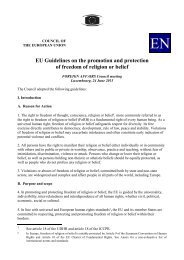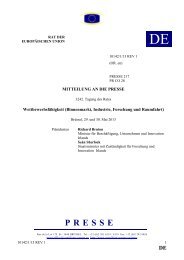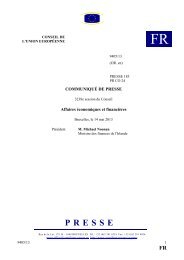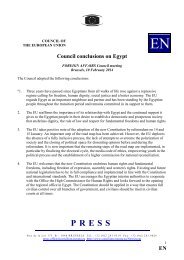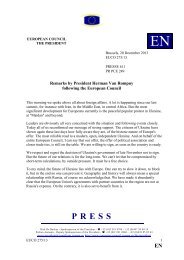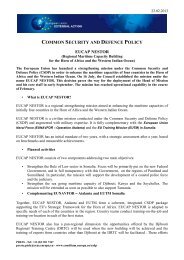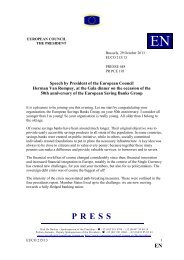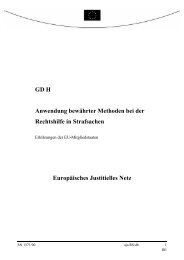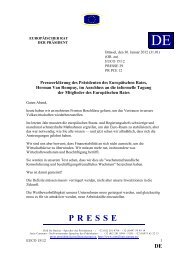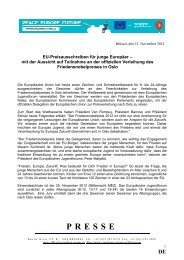14508/09 ADD 1 PL/vk 1 DG G COUNCIL OF THE ... - Europa
14508/09 ADD 1 PL/vk 1 DG G COUNCIL OF THE ... - Europa
14508/09 ADD 1 PL/vk 1 DG G COUNCIL OF THE ... - Europa
You also want an ePaper? Increase the reach of your titles
YUMPU automatically turns print PDFs into web optimized ePapers that Google loves.
The data is uncertain and, at least in some cases, it is not correct and therefore it is at this stage<br />
unsuitable for indicator 2. Yet a general preliminary conclusion is that when parental leave is more<br />
equally divided between the parents, it is because mothers' leaves are short, not because of any<br />
equality gains because fathers' leaves are long. In many countries fathers have a right to paternity<br />
leave around the time of birth. This leave is often paid and is to be taken at the same time as the<br />
mother is on maternity leave. When the fathers use these days, which seems to be common, and if<br />
mothers' leave is short, the parental leave appears to be more equally divided than when mother's<br />
leave is longer.<br />
There are also EU-SILC data, which show the proportion of children taken care of only by the<br />
parents, i.e. they are cared for mainly by their mothers and are not in any formal or other<br />
arrangement of childcare. In this respect there are big differences between EU countries. In five<br />
countries less than 30 % of children aged 0-3 are taken care of only by parents; in six countries<br />
between 30 and 50 % are taken care of only by parents; in five countries more than half the children<br />
but less than 70 % are taken care of only by parents and in the remaining six countries 70 % or<br />
more of the children are taken care of only by parents (see figure 4.6.2). The proportion of children<br />
in this age group that are taken care of only by parents probably mainly depends on the length of the<br />
maternity/parental leave, the extent to which it is paid and the availability of childcare. In the<br />
Nordic countries formal childcare is widely available. In Finland, where parents can be on leave<br />
until the child is three years old, a very large proportion of the children in that age group are taken<br />
care of only by parents (70 %), in Sweden parental leave is 16 months and more than half (52 %) of<br />
the children are taken care of only by their parents and in Denmark the corresponding figures are<br />
10.5 months and 26 %.<br />
Among older children as well – from 3 years old to compulsory school age – the variation in the<br />
proportion of children who are taken care of only by their parents is large between countries – from<br />
1 % in Belgium to 46 % in Poland. In twelve countries, the proportion is below 10 %; in seven<br />
countries from 10 % up to and including 20 %; over 20 % in six countries.<br />
Indicator 3: There are harmonised EU statistics on the provision of (formal and other) childcare<br />
arrangements within the context of the EU Statistics on Income and Living Conditions (SILC).<br />
<strong>14508</strong>/<strong>09</strong> <strong>ADD</strong> 1 <strong>PL</strong>/<strong>vk</strong> 87<br />
ANNEX <strong>DG</strong> G EN



